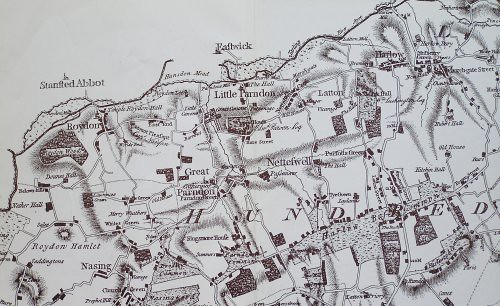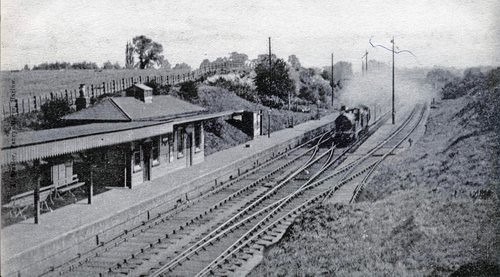Transportation
Roads and Coaches
The plan of Harlow is partly determined by the fact that by 1600 one of othe main routes north from London passed through it. The London Road ran north from Epping to the Harlow market place where it turned east down High Street to Mulberry Green, then north along Old Road to Cambridge via Sawbridgeworth, Bishops Stortford Hatfield Broad Oak, Thaxted and Saffron Walden. The Green Man Inn at Mulberry Green, first recorded in 1444, was an important coaching inn until 1828. the, as part of its scheme for road improvements between London and Bishops Stortford, the Hockerill Turnpike Trust completed a new stretch of road, originally called New Road, (now Station Road) from the Great George Inn at the top of High Street, to Harlow Mill. Henceforth, traffic between London and Cambridge bypassed High Street and Mulberry Green. A milestone showing the distances to Bishops Stortford (6 miles), Epping (6 miles) and London (22 miles to Whitechapel Church) is located in Station Road just north of Market Street.
This was a busy stretch of road. In 1812, peak London-bound traffic occurred on Tuesdays, Thursdays and Saturdays with five coaches each, and the addition of three wagons and a cart on Tuesdays, one wagon on Thursdays and two wagons and a cart on Saturdays. In 1838 three coaches, the Royal Mail, Magnet and Telegraph, called at The George every morning on their way from Norwich to London. It would not have been a very easy journey by today's standards. The Royal Mail coach left Norwich at 4:30 pm, reached Harlow at 3:50 am and London at 7 am, 14.5 hours after its departure. The return coach left London at 7 am, reached Harlow at 11:16 am and Norwich at 10:45 am the next morning.
Mail service to Harlow began in 1823. Mail left London by coach at 8:00 am, and arrived around noon. Replying by return post was quite possible, as the southbound mail coach left Harlow at 3:10 pm, reaching London at 7:00 p.m. The main post office moved into Gothic House at the intersection of London Road and High Street in 1909. At least through the 1930s the mail was delivered in the town on weekdays and Saturday, at 7:00 and 9:30 a.m. and 6:00 p.m. But, alas, there was only one delivery on Sunday!
Construction of the A414 beginning in 1962 drastically reduced the congestion on Station Road. However High Street continued to handle vehicular traffic until 1970 when it was pedestrianized and traffic bound for Mulberry Green and points east was diverted along the new Wayre Street to Gilden Way (the B183, or Sheering Road). Unfortunately, this destroyed the continuity of the Market Street/High Street/Churchgate Street axis which had linked the various parts of Harlow for centuries. The reconstruction of Gilden Way to accommodate the increased traffic that will result from the addition of a new exit from the M11 will increase the difficulty of maintaining a connection between the two parts of the town.
In 1975 the Harlow District Council was awarded a special Civic Trust Award for its 'continuing contributions to conservation', specifically for having transformed 'a traffic-choked village high street into a successful and picturesque shopping precinct'. The medallion, one of only 20 donated by the Worshipful Company of Goldsmiths, was presented to the Chairman of the Council by HRH the Duke of Edinburgh at Windsor Castle. That year had been designated European Architectural Heritage Year, and the Council also received a European Heritage Medallion in recognition of the High Street project.
In 1975 the Harlow District Council was awarded a special Civic Trust Award for its 'continuing contributions to conservation', specifically for having transformed 'a traffic-choked village high street into a successful and picturesque shopping precinct'. The medallion, one of only 20 donated by the Worshipful Company of Goldsmiths, was presented to the Chairman of the Council by HRH the Duke of Edinburgh at Windsor Castle. That year had been designated European Architectural Heritage Year, and the Council also received a European Heritage Medallion in recognition of the High Street project.
The Stort Navigation
The Stort River flows south from Bishops Stortford and joins the Lee at Hoddeston, connecting West Essex to London. Its usefulness as a transportation artery was seriously reduced during the Middle Ages as the number of mills, with their ponds and dams, increased. By the 18th century the growing demand for malt to feed the insatiable appetites of London brewers and the increasing abilty of Essex farmers to meet that demand made it imperative to improve the navigability of the river. Work began as early as 1424, but the major transformation of the river didn't occur until the founding of the Stort Navigation Company in 1740. The canalization project required several cuts across the neck of meanders in order to shorten the channel length, as well as the building of 15 locks. When the job was completed in 1769, Ware and Bishops Stortford were once again efficiently connected to London. Later ambitious plans to connect Bishops Stortford to the River Cam at Cambridge were never realized.
The advent of the railway in the 1840s had a disastrous effect on the canal. Revenues plummeted and a long process of deterioration set in under a series of owners, although Joseph Arkwright of Mark Hall, an implacable foe of the railway, subsidized the operating costs of the canal for some years in a vain effort to keep the company afloat. But the directors sold out to The Lee Conservancy Board 1911. Many of the locks were rebuilt during the 1920s but the major use after that time was for recreational boats. The last horse-drawn barge transited the canal in 1952, but a fleet of self-propelled steel barges operated along the canal until 1956.
The towpath is accessible in both directions at Harlow Mill and still provides a wonderfully peaceful and scenic walk through the Essex countryside. You can walk or cycle north through Sawbridgeworth to Bishops Stortford, or south all the way to London. If you're heading to London, you'll come to the junction with the Grand Union Canal. Here you can turn eastwards (right) onto its towpath. Or you can proceed straight ahead, following the Limehouse Cut. In either case you'll end up at Limehouse Basin on the Thames. The 30 mile journey from Harlow Mill lock to Limehouse takes about three and a half hours by bicycle.
The Railway
In 1836 the Northern and Eastern Railway Company secured an Act of Parliament authorizing them to build a railway from Islington in north London to Cambridge. The company’s long-term goal was to build on from Cambridge to York, but when the Great Northern Railway Bill was passed by Parliament in 1846 to permit another line direct from London to York, these plans were abandoned.
Typically the company had to deal with the opposition of landowners who were horrified at the prospect of a rail line crossing their property. One was Joseph Arkwright of Mark Hall who petitioned the House of Commons in a vain attempt to keep the railway off his land. Because he was convinced that the line would never go beyond Bishops Stortford he argued that it "cannot be of any public advantage sufficient to justify the proposed invasion of the property of your Petitioner". However, he agreed to withdraw his objection when the company offered him in £7,800 to compensate for the thirteen acres required.
The line reached Harlow in 1841 and Cambridge four years later. Passengers could board, or disembark from the trains at two places: a halt at Burnt Mill to the west and a station north of the town at the end of the former New Road which was renamed Station Road in recognition of its new purpose. The Burnt Mill halt was demolished in 1960 when Harlow Town Station was opened and the original station was renamed Harlow Mill, reflecting its location close to the old water mill. The modern appearance of the station belies its importance in the late 19th century when it served the needs of the occupants of, and visitors to, the many big houses in the area.
Typically, the station attracted industry. The 1920 O.S. map shows the Epping Rural District Council sewage works across the tracks, and a set of cattle pens and a large goods shed in the station yard. The sewage works survived into the 1940s. By then the cattle pens had gone, but Holbrook and Sons, machine tool manufacturers, had built a large precision lathe plant opposite the station.
The Harlow station yard also contained the impressive Station Hotel, built in 1880 by local brewer Philip Chaplin, on land purchased from the Eastern Counties (later Great Eastern) Railway. The purchase agreement stipulated that a hotal costing no less than £450 be built within a year. The hotel never prospered. When I first saw it in 1977 it had been abandoned for many years, probably since the late 1950s. In the 1980s it enjoyed a brief new life as a nightclub (Cheeks) before being damaged by fire and demolished in the early 1990s.



